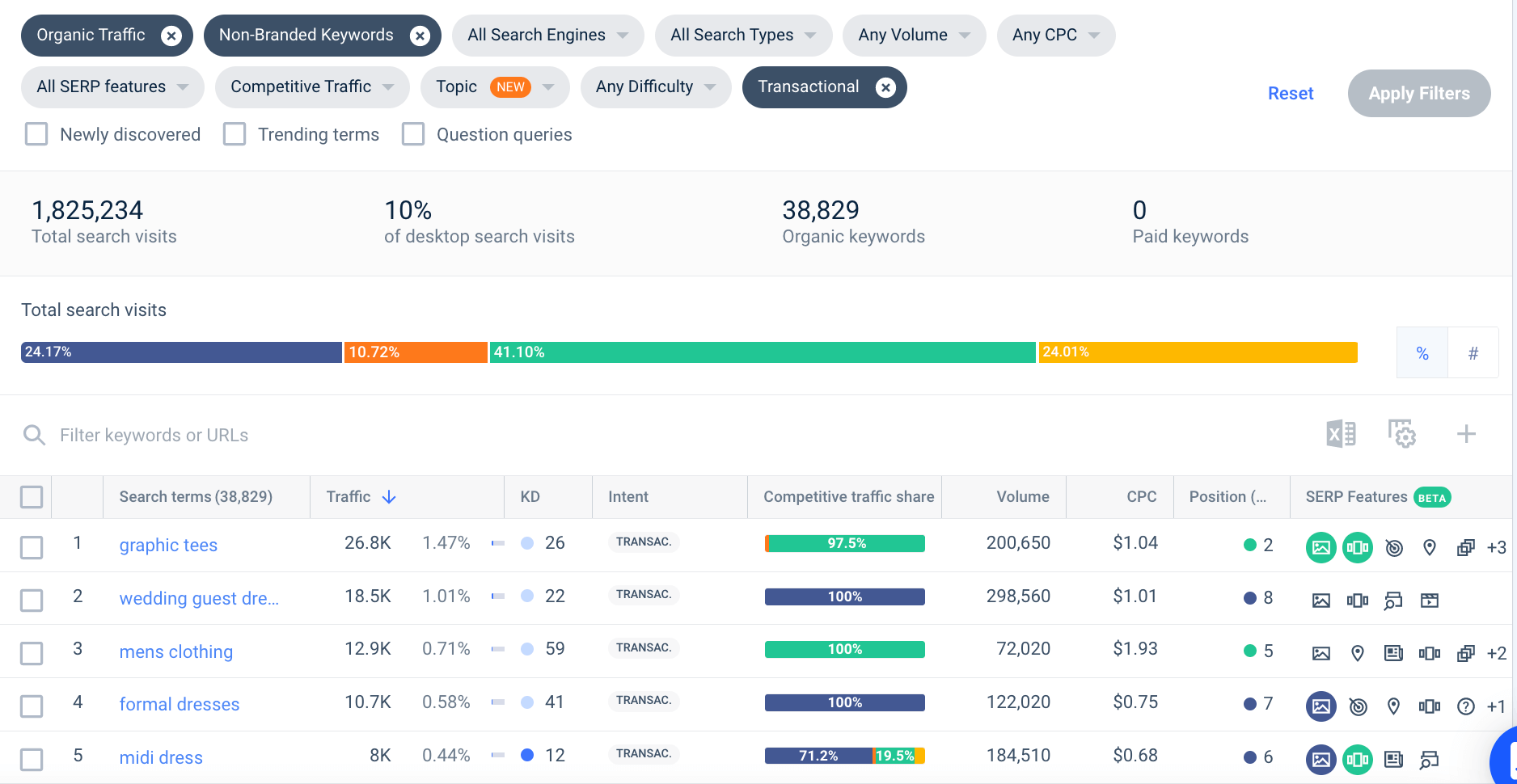 Marketing Intelligence
Marketing Intelligence
Search Intent: The Full Analysis & Optimization Guide

Pizza. What about it? Well, do you want to order, cook or find out how many calories are in the average pizza?
It’s tough to figure out what a person really wants when you only have a single word. And even when they use a phrase, it can still be challenging.
Google does a pretty good job determining user intent, and you should know a few things about how that works. You’ll find out in this article.
And that’s not all. You’ll also learn why analyzing search intent is critical for your SEO strategy. and how you can do it quickly and accurately.
What is search intent and why does it matter?
Simply put, search intent is the purpose behind a search. Is the searcher browsing for information? Do they want to make a purchase? Or are they just roaming the web to find a good deal?
Understanding user intent is understanding what a person is looking for or what their intent is when performing a search. User intent analysis takes into account the keywords being used but dives deeper in order to truly understand what the goal of the search is by analyzing the search semantics. Perhaps someone is looking for information or resources, others to make a purchase, or for a specific product or brand.
Unlike in our pizza example, people usually search for keywords or phrases that reveal intent. For example, instead of searching for just “pizza”, people type “simple pizza recipes”. From this keyword, we can determine the user’s intent to bake some pizza and needs instructions on how to do it – a pizza recipe.
Understanding the keyword intent, or why someone is searching for something, also helps SEO strategists and marketers develop a content strategy based on search terms that will bring relevant users to their website. Search intent optimization is vital to improving your SERP ranking.
Types of search intent
Google categorizes keyword search intent into four different types:
- Informational
- Commercial
- Transactional
- Navigational
Have you ever heard of the “do, know, go” concept? Do, know, go is the idea that search intent can be broken down into three main categories that represent the action that the searcher wants to take. Let’s take a look at the three main types of search intent to try and understand how keyword intent can affect your SEO and content marketing strategy.
Informational intent – I Want to Know
Informational intent is when people are looking for information. Nowadays, with mobile searching being so popular, micro-moment searches are commonplace and usually information related. Imagine shmoozing with your friends about past TV shows, and suddenly it turns into a heated discussion about when the season finale of Seinfeld was. Do you know? The debate can go on until someone pulls out the phone and searches. This search would have informational intent, meaning your reason for searching is that you want information.
Often, but not always, users with informational intent phrase their searches with a question. These searchers will usually exit the SERP once they get their answer.
If you run a commercial website, you may think this type of website visitor is useless since they won’t make a purchase or convert. However, they’re still worth targeting. Answering informational intent searches is a great way to demonstrate relevance and prove to the Google algorithm that your website has E-A-T (Expertise, Authoritativeness, and Trustworthiness). This significantly improves your ranking.
If your website provides a lot of information, you may want to create a strategy for targeting informational intent searches. Let’s say you run a blog about digital marketing – many people who want to improve their knowledge in the field roam the web for information or updates.
Information-hungry searchers might enter “How to write good ad copy” or “How to create a social media calendar.” You want to target these keywords if your website provides content that answers these questions. You’ll give visitors the information they’re looking for and attract potential prospects to your website. How do you target them? Well, we’ll get to that later.
Informational Intent Examples
- How to analyze search intent?
- Why do snakes shed their skin?
- What’s the weather forecast?
- When is Thanksgiving?
So, when was the last episode of Seinfeld? Did you find the answer? Let’s take that query.
Notice, you don’t even have to click through to any website to get this query answered. The search engine provides the information.
Navigational intent – I Want to Go
Navigational intent categorizes the searches for a specific website, a web service, or an app. It can also include local searches for public service facilities or similar. The search engine recognizes that the searcher intends to navigate to a specific location.
Someone may want to find the website of a particular brand but doesn’t know the URL. And who wants to go through the trouble of typing a URL in a search bar, anyway? So, the searcher types “Gap”, “Netflix”, or “Similarweb” into the search bar, and Google shows them the way to the brand website.
Also, when someone wants to find an official website or public service, they usually just want to get there without being offered special deals or background information.
It’s a bit of a gray area whether navigational intent searches should be included in your SEO strategy or not. Unless you are a widely known brand or offer a unique service, you may not attract a lot of navigational searches.
People set on a specific brand probably have a good reason and may not be interested in competition (like file a complaint to customer service for something they bought).
On the other hand, if users are searching for your company, make sure they find you rather than one of your competitors.
Navigational intent examples
- Gap
- University of Pennsylvania
- Solitaire game app
- Hospitals near San Jose
OK, time to put it into context and look at what the query “Gap” shows in SERP results. Here we can see that Google identifies navigational search intent and shows the brand’s website and its physical location. Notice, there are no ads or offers.
Transactional intent – I Want to Do
Transactional intent is when a searcher is looking to take action and potentially purchase a product or service. These searches are transactional queries that have high-intent keywords and that can be particularly useful for eCommerce stores as the user is often ready to complete the checkout by hitting the “buy” button. When a searcher is ready to buy, Google classifies them as having transactional intent. The search engine wants to present these searchers with the best opportunities to carry out their intentions straight away.
When people have decided to part with their money, they still want the best deal. The search terms are slightly different than someone just checking what’s in the market. The keywords may include a brand or a specific feature they’re looking for. The words they will use for their search will often be “do” keywords. A “do” keyword can be something along the lines of “food processor price” or “blue sweatpants”.
What would that look like? Here are the Google results for “Dyson vacuum prices” to show you what’s considered relevant.

When identifying transactional intent, the SERP gives the searches everything they need to go through with the purchase.
Transactional intent searches are the most likely to result in a conversion or a purchase. However, to get there, your site needs authority, and the audience needs to trust you, so focusing on transactional intent alone is risky. If you have an eCommerce store, you should consider SERP features and include these types of keywords to boost your ecommerce SEO. Identifying the correct user intent and adapting your SEO strategy in these cases can be incredibly beneficial for relevant businesses, targeting customers when they are ready to purchase.
Transactional intent examples
- Buy running shoes
- Coupon for Shein
- Where to buy dog food online?
- Vacation deals to Jamaica
Commercial intent – I Want to Choose
Searchers with commercial intent are looking for a product or service but haven’t yet decided if or what to buy. They are investigating their options.
Often commercial intent searches aim at product information, reviews, and comparisons. Searchers might google “best vacuum cleaner” or “Dyson vs. Shark vacuum.” These types of searches can also be location-specific when a consumer searches for the top restaurants near them or the best hotels in their next vacation destination.
Commercial intent examples
- Top restaurants near me
- Best hotels in NYC
- Review of LG smartphone
- Honda vs. Toyota
Let’s see what SERP results we find when we search the query “best vacuum cleaner” to put theory into practice.

The results include some ads at the top, but mainly content that helps the searcher in their decision-making.
Commercial intent searches are highly valuable for SEO because they drive potential buyers’ traffic. Content that targets this type of intent helps grow awareness of your brand, builds your authority, and strengthens credibility.
How does Google see search intent?
According to Google, the traditional marketing funnel needs a makeover. Customers don’t always follow a typical journey and jump back and forth through different stages. Because of this, marketers can’t rely on customers being in a particular funnel stage just because their last interaction was in the previous stage. Sound confusing? Here’s an example.
Let’s say John is in the market for a new blender. In the traditional customer journey, John would first become aware of his options, then consider which is the best for them before making a purchase decision. However, this journey is a little outdated when the entire internet of information is right in the palm of John’s hand.
Today, he may start researching blenders but then stubble upon a food processor that also works as a blender. He might spend months looking at food processors and blenders before deciding. Marketers need to align the way they speak to John with his current intent instead of his assumed funnel stage. How can marketers do this? By inferring intent.
This is what Google crawlers and other search engines do when determining what type of results to give John. Rather than relying solely on someone’s history, Google infers intent based on specific behaviors during a search, including keywords or modifiers that someone types in the search bar.
Here are a few keywords and modifiers that can signal intent:
When it comes to analyzing keyword intent, Google’s results are impressive. You can benefit from the company’s experience by analyzing results within the SERP. Try searching for a keyword that you believe is related to your website. What do the results look like?
If you see specific information, such as the date of the last episode of Seinfeld, Google considers this keyword as one with informational intent. If you see a carousel of different products, such as the Dyson vacuum, Google assigns transactional intent to this keyword. You can generally figure out the keyword’s intent type based on the results in the SERP.
Chances are that the top results meet the search intent that the user desired. Try to understand if the user search intent is informational, transactional, commercial, or navigational to better understand what the user wants. Analyze the pages at the top (as well as the rich results) to understand why they gained ranking, what value are your competitors able to provide users, and how they matched it to the search intent. Then, evaluate your asset to see if it fits in with your content for the query, and update the copy accordingly.
Another important aspect of this is the SERP visibility for the different intents – it will not look the same for buying intent queries as it does for informational queries. For different industries and topics, there will be different types of rich snippets and information cards, and those also have to be taken into consideration when evaluating the impact your SEO efforts may have on your website traffic as well as SERP visibility.
Analyze the entire scope of results for the 4 types of search queries to understand how they vary and decide how to build your strategy for approaching them. Analyze which types of queries might give you quick results and allow your site to gain visibility and which types of queries tend to take more time to rank well and provide traffic due to higher competition, a high rate of rich results, or other reasons. Analyze your own content – does it measure up to the competition? Does it provide users with the answer they were seeking? Does it provide a unique value that will allow you to stand out?
Once you have figured out the answers to these questions and mapped your query types correctly – You can move on to optimizing your content according to your analysis.
How to optimize your content for search intent
Let’s put it this way: Google has all the data. Google knows not only what users are searching for but what their thinking is behind each keyword they enter and tries to create the best user experience by optimizing the search results accordingly. Buying intent keywords will lead them to sites and landing pages where they can buy relevant products. Information searches will lead to Wikipedia and other informational sites or blogs to give the right information.
This is why you must integrate user intent analysis into your SEO strategy. Optimizing for user intent means targeting specific keywords that lead to high-quality content that maximizes intent relevance to your site and therefore increases your click-through rates. You need to create your content and SEO strategy with the consumer journey in mind. Always ask yourself, “What is my audience looking for and why”. Keep in mind that at different stages of your buyer journey, the search intent will change.
Analyzing and optimizing your content for search intent will greatly benefit your SEO. Not only will your website rank improve, but you’ll also likely see better conversion rates, a lower bounce rate, increased page views, and a wider audience reach.
If you’re targeting informational intent, you may even get the coveted Featured Snippet above the first search result in the SERP.
A Featured Snippet is a type of SERP feature where Google highlights specific text within the SERP. It means Google sees you as the expert on this subject!.
Each keyword-optimized page on your website should respond to the relevant user intent. Analyze the keyword search intent and then optimize content accordingly. Here’s how to do it.
1. Figure out the keyword search intent
Each keyword in your SEO plan targets a specific intent. A minor alteration can lead to different search intent, so you need to get specific and research each term.
What is the user typing this keyword looking for? Information? A specific product? To make a purchase?
Devote part of your keyword research to answering this question. How to do that? When you have collected a list of relevant keywords, add the intent for each keyword variation. Organize your list according to search intent, and prioritize keywords accordingly. You can do this quickly with the keywords tool in the website analysis function of Similarweb (Actually, the tool practically does it for you).
You can see that the brand names show navigational intent, and Google will show the brand websites first. Next, you can use the filters to hone in on the relevant keywords. You won’t be all that interested in branded keywords and can filter them out. Or you can limit the results to only transactional or commercial intent keywords
Pro-Tip: Sites use all kinds of techniques to signal their relevance for certain searches to Google. They could use images, product listing ads, local packs, and other SERP features to rank higher. Check what’s common and what works for your competitors.
2. Audit your existing content
Run an audit on your significant web pages or entire website to evaluate how well your SEO content aligns with search intent. Pages that target keywords with informational intent should answer questions and educate the reader. There’s no point in promoting your special deals and discount offers here. This is, however, a great way to build valuable internal links.
Informational content can link to pages targeting keywords with commercial and transactional intent. Your visitors benefit because you show them the way to more answers and solutions, and your SEO ranking gets a boost through thoughtful internal linking.
Pro-Tip: Your audit should also assert that the amount of content targeting each intent is proportional. For example, an ecommerce site selling popular branded consumer goods needs primarily transactional content. Informational content is crucial for B2B companies offering complex SaaS solutions. Use keyword research to identify navigational keywords and investigate relevance for your site.
3. Pay special attention to long-tail keywords
When you organize your keyword list based on search intent, you start looking at long-tail keywords differently. The magic here is you can target different intents with the same core keyword just by adding different tails. For example, this keyword targets informational intent: “how to find keywords for YouTube SEO?” by slightly changing the first words, you can ease over to commercial intent: “best tools to find keywords for YouTube SEO”.
Another way to utilize long-tail keywords is by finding synonyms and similar long-tail keywords that target the same intent. You can create more content and strengthen your authority on a subject. Google will reward your site with higher rankings. For example, if you want to be recognized as an expert on keyword gaps, you’ll start by targeting:: “How to do keyword gap analysis” and add “… for the financial industry” or “… in ecommerce.”
Pro-Tip: Search intent is critical to consider when analyzing keyword gaps. Benchmark the amount of traffic each site receives and see if there are discrepancies in search intent as well. Does a specific competitor get more traffic for his commercial intent targeting pages? Check them out and see how they do it. Pay attention to search intent when analyzing keyword gaps. Similarweb offers additional differentiations to Google, such as job search intent.
4. Steer away from search intent mismatch
Intent mismatch is when something goes wrong in the process and the intent of the searcher has nothing to do with the product or service you are offering. This can happen with keywords that have multiple meanings for example.
When Google isn’t sure what a searcher’s intent is due to multiple meanings or multiple businesses with the same name (think restaurants, for example) it bases its SERPs on dominant or common interpretations. Other factors may be included such as location.
5. Leverage fractured intent
Fractured intent (or multi-intent) is when a keyword leads to results with multiple types of intent.
In this case, SERPs will usually feature the top articles for a particular keyword, no matter what their specific intent. This is why making sure that your content is always accurate and excellent is important.
6. Always consider user intent, buyer personas, and the buyer journey
User intent SEO is important in order to target the right buyers and lead them into the correct marketing funnel. As you consider how to create your buyer journey make sure you’ve thought about who your target audience is and create specific buyer personas.
By understanding the search intent behind each specific keyword, you’ll be able to lead the right traffic to the right location. After all, it’s a waste of your marketing resources and budget if the wrong traffic is hitting your site. Your numbers may be high but your conversion rates won’t be.
Once your website is aligned correctly with users’ search intent, traffic starts arriving at your website and you’ll be able to lead them down the appropriate funnel stages. If you know that you’re using informational intent keywords, you can provide large doses of relevant information to visitors at first so they understand your value. If your visitors have transactional intent, you’ll be able to lead them into your product sale funnel right away.
7. Analyze organic competitors
Let’s stay with the benchmarking idea for a bit. Collecting data on your direct competitors and industry is a standard for marketing research. However, you need to identify your organic competitors to boost your ranking on search engines.
In other words, you need to know who you compete against for traffic from your target keywords. These sites may not always be competitors, or they may not even be in your industry. The reason could be the different search intent is different than what you thought.
Make sure you know who your competition is. You want to benchmark against your direct competitors and compare the keywords they are targeting.
Pro-Tip: Use the exact keyword or keyword phrase in your image alt text (the alternative text that appears if an image doesn’t load), in your page’s meta tags, and in your blog content. If you add secondary keywords, make sure they have the same intent. You wouldn’t want to confuse the algorithms.
8. Be aware of zero-click searches
When you identify keywords with informational intent, pay attention to zero-click results. For popular search terms, Google often displays info right in the SERP, so the user doesn’t need to click to get the answers they seek. Remember the date of the last Seinfeld episode? – Zero clicks for a high search volume keyword, right there.
This has implications for your content creation plan. You need to evaluate if a zero-click keyword is worth including in your SEO strategy or not. It may impact what Google makes of your site, but you won’t get any traffic or conversions from it.
Pro-Tip: Similarweb keyword research tool has a zero-click feature that shows you the percentage of zero-clicks for each keyword. This helps you quickly identify the search terms from which you can’t expect much traffic and optimize your SEO strategy accordingly.
Create and optimize content to meet search intent
As SERPs become more and more competitive as more businesses are going online, taking user intent into consideration in your SEO strategy is essential. Traditional SEO strategies are important but are simply not enough.
The structure and content of your website should be designed to support high SERP ranking and respond to the user’s intent. That means you want to clearly signal to Google which search intent pages respond to and simultaneously make it easy for visitors with different intents to find what they came for and seamlessly move in different directions.
When building a strategy, we recommend taking a user-focused and content strategy approach. Providing the right content that is useful for your searches is an important way to climb the rankings and hit the top. When you understand what search intent is and why it’s important, your SEO strategy will become more effective, bringing in positive results.
You want to organize your pages according to keyword clusters for better ranking. To satisfy the target audience, ask what other insights the visitor might find interesting. What could convince a visitor who followed commercial search intent to take the next step down your funnel, or what additional media and incentives can you offer someone who landed with transactional intent on your product offering?
The takeaway
The most important thing after (or maybe even before) ranking high on Google is to adapt your SEO and content strategies to your target audience’s needs and wants. Search intent provides a super valuable hint at what they are.
With a keyword generator that identifies search intent, you take out the guesswork and quickly understand what your audience is looking for. This way, you can provide users with the best experience while searching.
FAQs
What is search intent and why does it matter?
Search engines attempt to identify the user’s intention when typing in a specific keyword and then categorize the search accordingly. This helps match the SERP results to the query and increases the chance for the user to find what they came for.
What are Google’s 4 types of search intent?
Google differentiates between four search intents: informational (gain knowledge, data, instructions. etc.), commercial (evaluate a product, service, investment, offer), transactional (make to purchase), and navigational (reach a specific website).
Why analyze keywords for search intent?
You want to make your SEO content matches the right intent for each keyword. Google will not show your coupon for a special product offer when the page targets a keyword with informational intent.
Wondering what Similarweb can do for your business?
Give it a try or talk to our insights team — don’t worry, it’s free!

















